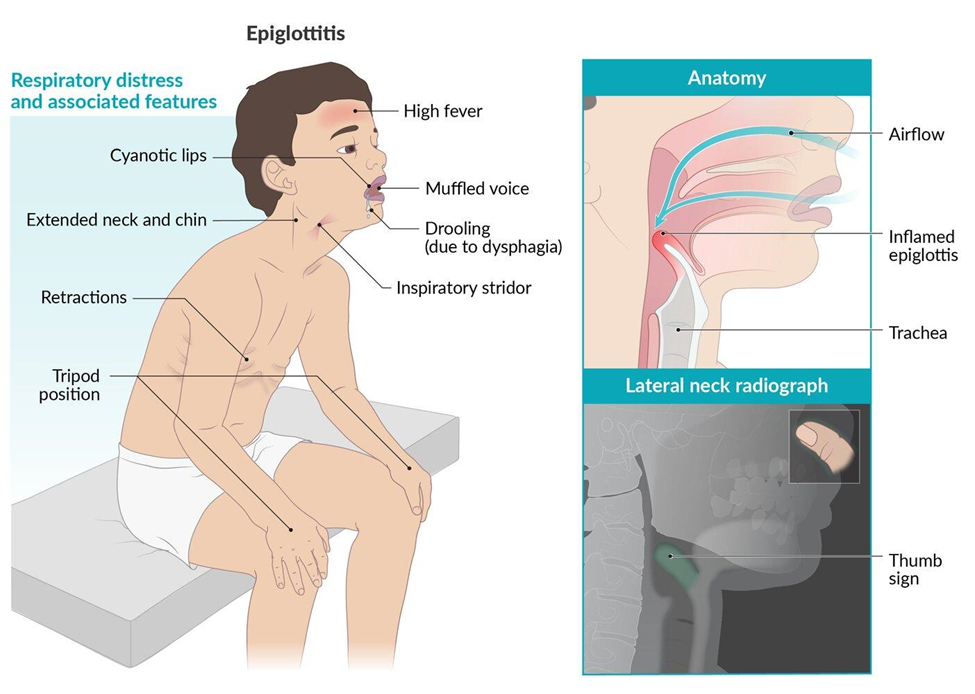A nurse is admitting a child who has suspected epiglottitis. Which of the following actions should the nurse take first?
Administer 0,9% sodium chloride IV solution.
Assist with obtaining an x-ray of the child's neck
Initiate IV antibiotics.
Place the child on droplet precautions
The Correct Answer is D
A. Administer 0.9% sodium chloride IV solution: Although IV fluids might be necessary to maintain hydration and circulation, this is not the priority over preventing the spread of infection.
B. Assist with obtaining an x-ray of the child's neck. Imaging can help confirm the diagnosis but should be done after ensuring infection control measures.
C. Initiate IV antibiotics. Antibiotics are crucial for treatment but should follow the implementation of droplet precautions to prevent the spread of infection.
D. Place the child on droplet precautions.
Epiglottitis is a medical emergency primarily caused by bacterial infections, such as Haemophilus influenzae type B (Hib). The first priority is to ensure the safety of both the patient and others by preventing the spread of infection. Placing the child on droplet precautions helps to contain the bacteria and protect healthcare workers and other patients.

Nursing Test Bank
Naxlex Comprehensive Predictor Exams
Related Questions
Correct Answer is B
Explanation
A. "I will have my child wear soft fabric clothing under the brace."
Explanation: Wearing soft fabric clothing under the brace can enhance comfort and reduce the risk of irritation. This is a suitable practice.
B. "I need to apply lotion under the brace to prevent skin breakdown."
Explanation:
Applying lotion under the brace may lead to moisture accumulation and skin breakdown. It is generally recommended to keep the skin clean and dry under the brace to prevent irritation and pressure sores. Lotions or creams can contribute to moisture, potentially causing skin problems.
C. "I need to avoid the use of powder because it will cake under the brace."
Explanation: Powder can accumulate and cake under the brace, leading to skin issues. This statement is correct, emphasizing the importance of avoiding the use of powder.
D. "I will encourage my child to perform prescribed exercises."
Explanation: Encouraging the child to perform prescribed exercises is essential for maintaining flexibility and strength. This statement reflects a positive and supportive approach to managing scoliosis.
Correct Answer is ["A","B","C","D","E"]
Explanation
A. The child and family will integrate diabetes care into patterns of daily activity:
Correct Answer: Correct.
Explanation: Integrating diabetes care into daily activities helps the child manage their condition more effectively. This goal encourages normalization of the routine, making it easier for the child to participate in social events.
B. The child and family will discuss all aspects of the illness and its treatments:
Correct Answer: Correct.
Explanation: Open communication about the illness and its treatments is crucial for understanding and managing diabetes. This goal promotes family education and support, which can help alleviate concerns.
C. The child will use effective coping mechanisms to manage anxiety:
Correct Answer: Correct.
Explanation: Managing anxiety is important for overall well-being. Teaching the child effective coping mechanisms helps them navigate the emotional aspects of living with diabetes and participating in social events.
D. The child and family will discuss their concerns with the child's teachers and the school nurse:
Correct Answer: Correct.
Explanation: Communication with school personnel is essential to ensure a supportive environment for the child. Discussing concerns with teachers and the school nurse promotes awareness and collaboration in managing the child's diabetes at school.
E. The child's normal growth and development will be maintained:
Correct Answer: Correct.
Explanation: Maintaining normal growth and development is a crucial goal. It ensures that the child can engage in age-appropriate activities and social events while managing their diabetes effectively.
Whether you are a student looking to ace your exams or a practicing nurse seeking to enhance your expertise , our nursing education contents will empower you with the confidence and competence to make a difference in the lives of patients and become a respected leader in the healthcare field.
Visit Naxlex, invest in your future and unlock endless possibilities with our unparalleled nursing education contents today
Report Wrong Answer on the Current Question
Do you disagree with the answer? If yes, what is your expected answer? Explain.
Kindly be descriptive with the issue you are facing.
